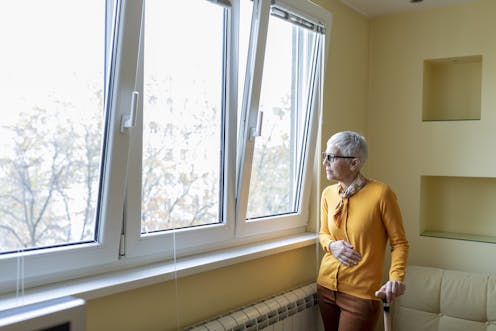Stroke survivors may be saddled with an invisible disability known as spatial neglect – but a simple
About half of those recovering from a stroke or a brain injury have spatial neglect. But prism adaptation therapy – noninvasive and easy to administer – can help.

_More than half of stroke survivors do not receive rehabilitation after the first days of advanced stroke care. Instead of living for months or years with visible or hidden disabilities, stroke survivors can take advantage of new techniques of advanced rehabilitation to improve their function and freedom.
One condition, called spatial neglect – in which a person’s three-dimensional reality and spatial movements are distorted on one side – is particularly underdiagnosed and undertreated among those who have suffered strokes and other brain injuries.
The Conversation asked neurologist A.M. Barrett and optometrist Kevin Houston, both from UMass Chan Medical School, to explain what causes spatial neglect and how to recognize it.
What is spatial neglect?
Some stroke survivors struggle when navigating the world around them. They walk, sit or stand in a tilted or unbalanced way. Even looking to the side may be challenging. This condition, known as spatial neglect, is a common occurrence after a brain injury.
About half of those in the first weeks and months of stroke recovery have spatial neglect; it is more common after a right brain stroke. Unlike other paired organs, the brain is functionally specialized, and the right brain is dominant for visual-spatial computations and actions.
Although spatial neglect can be accompanied by visual problems or paralysis, especially on the left side of the body, it is a separate problem that makes driving, reading, returning to work and daily self-care many times more difficult.
Most of us take for granted the ability to move and react effortlessly to what is happening around us. But these things are difficult for people with spatial neglect. Their internal map of the three-dimensional world is unreliable on one side.
How common is spatial neglect?
In some people, spatial neglect goes away with time. But in the U.S., 350,000 people live with spatial neglect for six months or longer. That number is likely higher – perhaps three times as high – but there’s no way to be certain; it’s estimated that fewer than half of those with spatial neglect are diagnosed and treated.
How can you recognize spatial neglect?
A person with spatial neglect may be unable to steer a wheelchair straight ahead and instead may steer to the right in tight circles. When putting a shirt on, they may put their right arm through the sleeve but not the left, or vice versa. Or they may lay out their medications, but only reach to one side, so they may take only half of their medicines for that morning. Someone with spatial neglect may inadvertently sit on their affected arm, or let it hang off the side of the wheelchair.
When chatting with a group, a person with spatial neglect may turn to the wrong person to respond. This is because their spatial system, which tells them who just spoke based on that person’s location, is disoriented. The spatial system is also critical when helping us react to a sudden event, like a car swerving out of its lane toward us when we’re driving.
One reason why this condition goes undiagnosed is because caregivers don’t see the postural and movement changes in spatial neglect as a specific brain problem. Instead, when they see the person sitting persistently turned, or leaning and tilting to the right, they just respond intuitively, with assumptions that the person is unmotivated, depressed or has an intellectual problem caused by the stroke.
Caregivers may also think these unusual movements are part of the weakness caused by stroke. However, people who only have weakness will compensate. They usually do not turn or lean to one side persistently.
Most disturbing for those with spatial neglect: The internal alarm system that helps them detect everyday mistakes is off. They are unaware they are having difficulties walking, reacting, moving or responding, so they don’t see the need to ask for help. This has a devastating effect, not only on their perception of the world but on their dignity.
What causes spatial neglect and how is it related to stroke?
There are networks and way stations in the brain, specialized in managing how our body interacts with the three-dimensional world. Spatial neglect occurs when these networks, or the wiring connecting them, go offline after a stroke.
For example, if someone points to something – like a sign they want someone else to see – a “ballistic system” in their brain sets a target and bearing so that the movement is aimed correctly. But if a person with spatial neglect tries to point to a sign, they may point incorrectly, perhaps to the right side of the sign.
This aiming error can cause falls as stroke survivors try to get up from a chair, walk or turn, sometimes even pulling down the person trying to assist them. These accidents can devastate their recovery and freedom.
How does it differ from limb paralysis or vision loss?
It is not weakness or paralysis on one side of the body that causes unbalanced posture and movements. Instead, someone with spatial neglect is not aware they are leaning or veering. From their perspective, movements are targeted straight ahead.
Those with spatial neglect often have vision problems too, but that doesn’t mean anything is wrong with their eyes. They can see. But because of their stroke, their brain ignores some of the visual information.
If spatial neglect is treated, the patient may be able to adjust for their vision issues and regain independence in daily life much more successfully.
What are the promising treatment options?
Treating spatial neglect through an approach called prism adaptation therapy actually increases the patient’s ability to move and track the affected limb, and can even reduce pain affecting the bad side.
The therapy is simple to administer, using off-the-shelf optical prisms over 10 therapy sessions of 20 minutes each. Essentially, a stroke survivor wears goggles during the session and practices aiming their spatial movements. The therapist will ask the patient to repeatedly point to and touch a dot placed on the table in front of them, or ask the patient to repeatedly mark the center of a line. This appears to correct the rightward-turning tendency after spatial neglect.
Prism adaptation therapy has been recommended by the American Heart Association and American Stroke Association, and our group has provided this treatment to patients for more than 15 years.
After prism adaptation therapy, the ability of most patients to aim movements toward the neglected side is greatly improved. Our therapists have measured the increase in leftward movements after even one treatment session.
Other types of therapy for spatial neglect involves far more than 10 treatments. These sessions are more labor-intensive and require extensive training for providers. Such types of treatment are difficult to scale and unlikely to reach the hundreds of thousands of people diagnosed with spatial neglect.
How can I find a specialist?
First, ask your doctors and therapy providers about treatment for spatial neglect. Neurologists specialized in rehabilitation, other rehabilitation physicians, speech language pathologists, occupational or physical therapists or optometrists specializing in visual rehabilitation might offer prism adaptation therapy. Make sure your provider is offering a treatment that is evidence-based.
Our group is currently receiving research funding from the Veteran Administration for a large national study to identify the people who might receive the most benefit. We hope the study will also provide doctors with a better understanding of the brain networks that are critical for treatment success.
A.M. Barrett ris named on a patent for a spatial neglect treatment device, for which she receives no monetary or other compensation.
Kevin Houston does not work for, consult, own shares in or receive funding from any company or organization that would benefit from this article, and has disclosed no relevant affiliations beyond their academic appointment.
Read These Next
RFK Jr. wants to scrutinize the vaccine schedule – but its safety record is already decades long
Federal officials are questioning the safety of the vaccine series children receive. Here’s the story…
Deception and lies from the White House to justify a war in Venezuela? We’ve seen this movie before
Two US wars based on lies, in which tens of thousands of American troops and millions of civilians died,…
Why it’s so hard to tell if a piece of text was written by AI – even for AI
There are several methods for detecting whether a piece of text was written by AI. They all have limitations…





